


| Uses of Dynamite in Hand Dug Wells |
This article by Christopher Henney was written as
an overview of the uses of dynamite in the Peace
Corp/Togo wells construction program.
It is reprinted from
the Action/Peace Corps P&T Program and Training Journal (Special Issue:
Wells Manual) published by the Peace Corps in 1974.
PART I: Obtaining ft
When to use dynamite
When and if you encounter a hard
rock layer and there is NO OTHER WAY to break
it in order to attain the aquifer, then dynamite Is
in order. Of course, you could move the well site,
but in some regions this probably would not make much
difference. Never use dynamite before It is absolutely necessary as
villagers will immediately start to rely on it as soon
as the going gets rough. It is very difficult to
stop using ft once you have started. Dynamite in an
old well or using dig-a-meter-pour-a-meter method Start with small charges
and deep blast holes and try to leave 50 cm
between caissons and rock.
How to get ft
Because it is an extremely dangerous substance and
can be used for sabotage or other crimes, most governments
are very caution about whom they give permission to use
dynamite; thus one's procedure for obtaining it should always be
through all necessary officials channels. In Togo this generally means:
1) Chef-Cir
2) Travaux Publics or
Assainissement
3) Interior Ministry
4) An authorized dealer
First you get your Chef-Cir to
address a "demande de permission d'achat" permission to buy request
to the Minister of Interior. This will state quantity and
type of dynamite plus quantity and type of detonators. What
purpose it is to be used for and where' where
it will be kept, and by whom. Attached to this
should be an agreement of your local boss; in my
case the Engineer of Assainissement Sokode. This letter will then
be transmitted to Lome (the capital) and will be returned
as a letter of permission to the bureau of the
Chef-Cir. He will give it to you. Remember this permission
expires after six months, so use it immediately. With this
letter you then go to Lome and order the dynamite
and detonators from Brossette et Valor (an authorized dealer). This
could take time as it must come from France. So
plan 6 months ahead.
Another option is to
have Travaux Publics-Service Hydraulique order it for you when they
order theirs. Especially if you only want one or two
cases. This is because Broesette requires a minimum order of
three cases unless you want to wait until it can
be attached to someone else's order. This also has the
advantage of free transport up-country. It is not always easy
to get a transporter to carry high explosives.
WHAT TO ORDER:
The Dynamite
There
are a number of kinds of dynamite or explosives adaptable
to wells. And the choice is probably bost made with
expert help. Service Hydraulique is your best bet or Service
des Mines. after wing three different types and talking to
a number of people, I decided on the type known
as "Comme A. Tolamite. This is a red gelatinous substance
rolled into 50 grms. packages by means of wax paper.
It is waterproof and maleable. The gases it releases upon
ignition are non-toxic {although they may frritate lungs, but I
will get to that later) and the stuff won't go
off if bumped, smashed, dropped, etc. The maleability is important
as sometime you want to squeeze it into a crack
like toothpaste. I generally figure quantities on this scale:
1 charge - 50 or 100 grms. dynamite
Meters depth of rock
Diameter of well
Quantities
Number of
blast holes
1 METER
1 meter ø
12 charges
3
1 METER
1 meter 25 ø
10 charges
5
1 METER
1 meter 40 ø
24 charges
6
1 METER
1 meter 80 ø
28 charges
7
This should be more
than adequate; usually it takes two rounds of explosions to
do a meter although this depends on the depth of
the blast holes and the hardness of the rock. Normally
your local water bureau or Travaux Publics will be able
to tell you how deep you will have to blast.
One case of dynamite weighs about 25-30 kg.
The Detonators
For each three charges, you will
need two detonators. This will insure an adequate supply. Make
sure they are electrical firing detonators. Fuses are dangerous and
should not be used. The best kinds are type B66
low intensity, total resistance 1.5-3 ohms, medium 2 ohms. Make
sure the wires are 2 m long.
In
general both dynamite and detonators have an expiration date. So
make sure you don't get an old batch, because it
may be unstable and therefore DANGEROUS.
Where to
Store and Now
The storage of dynamite is
most important for your own health and that of others.
Don't keen it at home as you may have kids
or ocher curious people around. Personally, I prefer to keep
ft at the local gendarmerie, police or travaux publics. This
has a number of advantages:
a) You cannot
be accused of sabotage for political reasons
b)
If you work on weekends, you can get it at
the first two places
c) If there is
an accident, you are not around or responsible
Keep detonators away from dynamite,if possible at the other side
of a locked room and in a case. Never let
dynamite and detonators come into contact until you are ready
to use them. Remember a good shock can set off
the detonators, and detonators can blow your hand off. Keep
tabs on how much you have and how much has
been used. If you cannot keep it at the above
mentioned locations, make sure you have a good store room
with lock and the only key in your possesion.
How to Carry to your Site (If You Must)
If you don't want to keep it at
the side because there is no adequate store room or
you have many sites and prefer to bring it in
when needed from a central store, then you must decide
how it will be carried. I personally don't like this
as there is a small amount of risk involved; but
I did it for over six months. Anyway, if you
follow certain simple rules, you should be all right.
1) Keep detonators and dynamite in separate waterproof sealed
cans - The detonators preferably in a plastic one.
2) Keep the batteries or exploder somewhere else in
your pack and separate from the detonators. This will insure
you except if you get hit by lightning or squashed
by a true*, both of which are very real dangers.
A normal crash because of sand, etc., should
cause you no problems. (I had two).
PART
II: Row to Use
Rules for Use in
a Well
The use of dynamite follows a
couple of rules of thumb:
a) Use common
sense
b) Don't use more than needed to
get the Job done
c) Make sure the
site is cleared of people
d) Keep children
away from site at all times
e) Get
someone else to trigger ft
f) Don't let
anyone else handle dynamite or detonators
g) Keep
the batteries in your pocket or pack until you are
out of the well and the site is cleared
h) Check whether all charges went off (see Part
III)
i) Never send someone else to get
dynamite or detonator. from the store room
j)
Never go down in a well containing unfired charges unless
you have secured the batteries
k) Place the
charges yourself.
Rules a, b, c, d, g,
j are constants, but e, f, i, k are changeable
if you have trained a competent person to do the
job. But no matter what happens, you will always be
held responsible.
Tools You Need
Assuming
you are working on a village level and you don't
have a jack hammer (compressor), you will need:
1) Mining bar
2) 75 meters of extension
cord flex
3) 1 roll of insulation tape
4) 1 flat file (to sharpen mining bar)
5) 5 flash light 1.5 volt cell batteries,
size D
6) Dynamite and detonators
7) One 2-meter spoon
How to Place Charges
As I have said before, the number of
charges is In proportion to the depth of the blast
holes and the diameter or the well. A good rule
of thumb is two charges per hole (blast hole) and:
3 holes for 1 m ø
5 holes for 1 m 25 cm ø
6 holes for 1 m 40 cm ø
7 holes for 1 m 80 cm ø
but depending on the rock, you may have three charges
per hole (or one). Never blast if your holes are
not deep enough. It is a waste of dynamite. The
blast holes should be at least the length of a
man's arm, 80 cm and preferably more. The deeper the
better. Blast holes should always be in the most protruding
places.
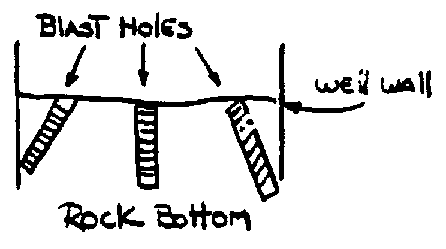
Figure A.
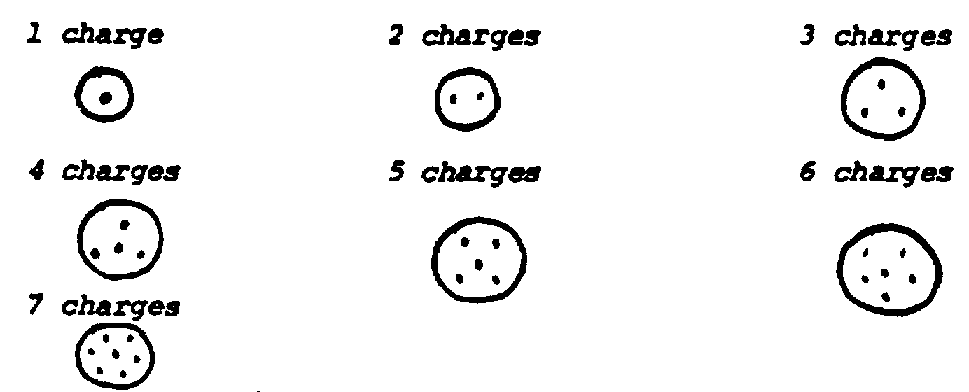
Here is a good diagram of where to place them in general
The charges toward the outside walls of the well should slope out as In Figure A and In the case of 4 - 1 charges.
How to Make up Charges
There are two methods thee I use: placing side by side, or one on top of the other.
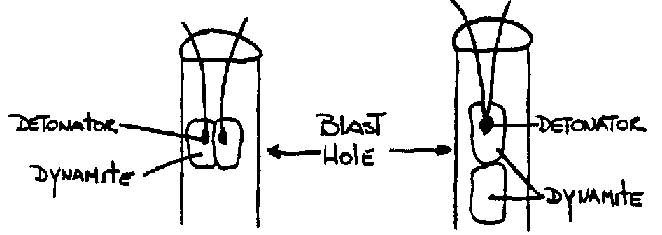
Figure B.
I prefer the side by side method where the hole is large enough. This is done by unwrapping the wax paper around the dynamite and sticking the two charges together, then rewrapping. The detonator is then inserted until completely inside the dynamite. This method has the advantage of never having only one charge go off because the other got covered by mud and separated from the first charge as in the one on top of the other method. But in really hard rock it is sometimes not always possible to make the blast hole wide enough. The one on top method is also better for really deep holes as you can put 3-4 charges in with no difficulty. I might also mention that the tighter the fit of the dynamite, the better blast you are going to get. once the dynamite is in the hole with the detonator securely in the dynamite, pack the hole with damp sand. And pack the sand with a stick so it is well in and well packed.
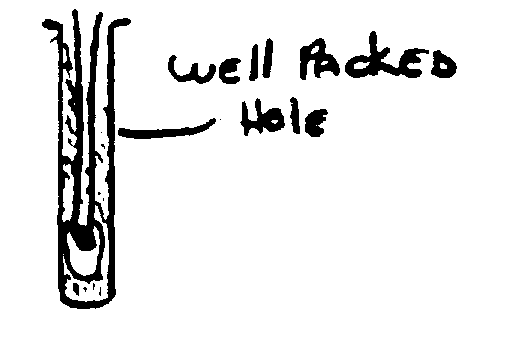
Well packed hole
Don't pussy-foot but don't pound as if you were driving railroad spikes. This insures that the dynamite has some thing to push off on and that the gas does not escape out the open hole. Never till your hole up to the top with dynamite. This just is a noisy waste.
If you have more than one charge as you will most of the tame, you most hook them up in series. Each detonator has two wires, on one will be a flag.

Figure C. (a)
Now in order to hook up a series, you must hook flag to non flag of another charge:
This leaves you with one flag and one non flag which is than attached to the extension cord that goes above ground. Next collect your ends and tie them to the extension cord:

Figure C. (b)
If you have four detonators, there should be five joints left out of the *not, and so on. Make sure those are separated so as not to cause a short circuit.

Figure C. (c)
Also make sure that this knot is above the water level- -Preferably as high as possible without pulling the detonators out - and that is easier than imagined even when the charges are packed in sand. Than get out of your well, being careful not to pull on the extension cord.
How to Dig the Blast Roles
Using the blade end of the mining bar, pound the rock. This must be done while continually rotating the blade so as to make a nice neat round hole. At intervals, add water to make a slurry - this is messy but necessary. After a bit, use the 2 mater long spoon to get out the dust and dirt made from pulverized rock; or if the hole is wide enough, use your hand. Never make holes wider than your hand (fist) as this is Just wasteful of dynamite.
The sand will be blown out and little rock will be blasted. This is hard work and can take several days.
Ignition
To set off the dynamite, place the four or five batteries end to end and touch the two ends with the two ends of the cord. Make sure you do this firmly and keep the cord touching until you have counted five (oven though the explosions will happen spontaneously). This could save you many hours of looking for live charges that did not go off. For 1-3 charges, four batteries. Add one battery for every additional charge; i.e.
for 5 charges, 6 batteries; for 6 charges, 7 batteries, and
for 7 charges, 8 batteries.
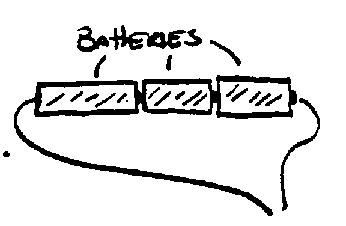
Figure D.
Before you fire, clear the site. Let no one stand nearer than 50 meters to the well. Let a Togolese do the firing. There are two reasons for this. If someone gets hurt you did not pull the trigger, and Togolese-American relations will not be upset. Also, you are needed to keep a sharp look out for
falling rocks, impulsive children, or new arrivals. But if anything does happen, you will still be responsible for the sit. and though not legally, you will be held responsible in the eyes of. the people you are working with.
Once the explosion has gone off waft a minute. You will often be surprised how long ft takes rock to fall back to earth. Then pull up the extension cord and count the number of detonator wires. If all have gone off great, but if one is severed half way up, there is a chance it is still alive. Also, if there is anything holding the cord don't yank ft up. This could well be the wire that did not fiew, and by following it you will easily find the unfired charge instead of digging all over to find ft. Now waft 15 minutes half an hour until the smoke clears. You can choke to death by smoke inhalation even if the smoke is not toxio per se.
What to Do if a Charge does not go off
First, climb down and check your detonator wires. If one stays stuck, dig around it reasonably carefully. (If an explosion could not sat the charge off, you would really have to try). There is not too much danger if you are careful. When you reach sand, pull the detonator out slowly, then dig out the charge. The charge is now harmless. Or you can also rewire the detonator, climb out, and fire ft. If this does not work and you cannot extract the charge, put a net one In on top of it and fire that. This way your well is clean. Then sand workers down but Nor until you have at least extracted the detonator(s).
The causes of unfired charges are:
1) A short circuit
2) A sot of old batteries (no power)
3) Old detonators
After each explosion, chock out your cable and patch or cut. Then place batteries at one end and the two wires on your tongue at the other end' if ft tingles, all is well. Coil and put away. If not, find the short. Always do this after each explosion. It saves embarassmant when nothing goes off. You can work in up to 1 meter of water.
Recap of Procedure Rules
1) Only use dynamite where nothing else works.
2) Never use before it is absolutely needed, even when the work is hard.
3) Follow all official procedures in obtaining it.
4) Make sure It is not outdated stuff.
5) Never we fuses, always electric detonators.
6) Don't keep it at home, store safely.
7) Never send an inexperienced person to got it out of storage. Go yourself.
8) Keep dynamite separate from detonators and detonators separate from batteries.
9) Use commonsense (take all the risks that need taking yourself).
10) Don't use more than you have to.
11) Make sure the site is cleared of people.
12) Keep children away from site.
13) Get someone else to fire it while you watch.
14) Don't lot others handle dynamite or detonators or batteries.
15) When you are in well, keep batteries in your pocket. This is your only insurance.
16) After explosion, chock for unfired charges.
17) Never go after unfired charges unless you hero secured the batteries
18) Place all charges yourself.
19) Always pack some sand on top of a charge.
20) Make sure your detonators are wired properly and that the jointed ends don't touch.
21) Tie the wires to the cord.
22) Make sure knot is above water.
23) Don't pull on cord. You might extract detonators by accident.
24) Lot no one stand clover than 50 m when you blast.
25) Touch batteries firmly. Count to five.
26) Chock for dead charges yourself.
27) Wait for smoke to clear.
28) Check extension cable after each explosion.
29) Keep tools in good repair.
30) Remember you are responsible for your life and other lives.
PLEASE NOTE: Under no circumstance should dynamite be used unless an exhaustive study concernong its use has been conducted by experts who are knowledgeable In the use of dynamite.
GOOD LUCK AND TAKE CARE.

